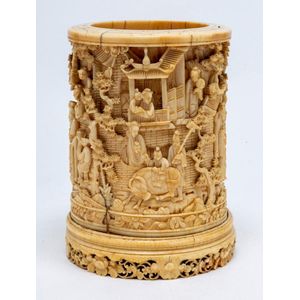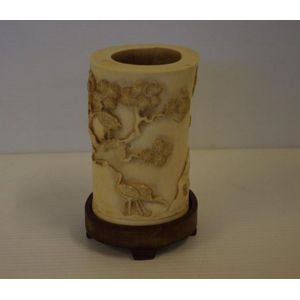
Qing Dynasty Chinese Ivory Brush Pot, 19th Century, 12cm
An antique Chinese carved ivory brush pot, Qing Dynasty, 19th century, 12 cm high,

Qing Dynasty Ivory Brush Pot: 19th Century Chinese Carving
A Chinese ivory carved brush pot, Qing Dynasty, 19th century, 13.3 cm high

Meiji Ivory Brush Pot with 100 Carved Faces
Japanese Meiji period well carved '100 faces' ivory brush pot, height 18 cm

Meiji Ivory Brush Holder with Elephant Incisions
Japanese Meiji period ivory brush holder, incised with images of elephants, base missing, with J.Loren Karas collection label, height 11 cm. Provenance: The Estate of the late Fernande Glynn, a well known Australian actress that appeared in classic…

Qing Dynasty Ivory Brush Pot with Intricate Carvings
Chinese Qing Dynasty carved ivory brush pot, of cylindrical form, intricately carved with various scenes of figures in pavilions with pine trees, raised on a pierced stylised lotus and foliate base, a/f, height 11.5 cm

Japanese Immortals Ivory Brush Pot
Japanese ivory and lacquer brush pot, of cylindrical form, decorated with a series of immortals and attendants on a tromp l'oeil textured surface, a/f, height 32.5 cm purchased: Sotheby's, lot 248

Dragon Ivory Brush Pots with Stands
Two Chinese ivory brush pots, 20th century, each carved on the exterior with dragons chasing flaming pearls in relief, wood stands, 11 cm and 12.5 cm high

Chinese Ivory Brush Pot with Landscape and Figures
A 19th century Chinese ivory brush pot decorated with figures and pagodas in a landscape setting and Chinese character script, 13 cm height,

Signed Japanese Ivory Netsuke: Scholar with Scroll and Brush Pot
A signed Japanese ivory netsuke. Taisho period, 1920s, the signed ivory netsuke depicting a standing scholar, with a scroll and a brush pot in his hands, lightly engraved and inked in black and maroon, signed to underside. Height 5 cm

Taisho Ivory Netsuke of Standing Scholar with Scroll and Brush
A signed Japanese ivory netsuke. Taisho period, 1920s, the signed ivory netsuke depicting a standing scholar, with a scroll and a brush pot in his hands, lightly engraved and inked in black and maroon, signed to underside. Height 5 cm

Chinese Ivory Brush Pot, Late Qing Dynasty
A small Chinese ivory brush pot, late Qing Dynasty, 19th-early 20th century each side of the brush pot carved with figures in a garden. 19/20 8.5 cm high. Provenance: an important private collection, Victoria, Australia

Chinese Ivory Brush Pot with Reticulated Landscape Carving
Late 19th century Chinese ivory brush pot. With finely carved, reticulated continuous landscape. Mellow age patina, fine age cracks. Minor losses. Height 9.5 cm. Provenance: Luciano Sita collection, Sydney.

Japanese Inlaid Wood Brush Pots by Arai, 19th/20th Century
A pair of Japanese wood brush pots by Arai, 19th/20th century, each of cylindrical form set on a carved wood base, carved in relief with a warrior attacking a wild animal embellished with ivory, mother of pearl and other inlays, inscribed on a rectangular…

Japanese Ivory Brush Pots with Carved Stands
A pair of Japanese pierced ivory brush pots, with carved wooden stands, 10 cm high

19th Century Chinese Ivory Brush Pots
A pair of 19th century Chinese finely carved ivory brush pots, depicting courtesan and scholars in mountain landscape. Height, 21 cm.

Dragon and Clouds Ivory Brush Pot with Wooden Stand
Chinese carved ivory brush pot, decorated continuously with dragons and stylised clouds, mounted in a carved wooden stand, overall height 18.5 cm

Qing Dynasty Ivory Brush Pot with Silver Base
Chinese carved ivory brush pot Qing Dynasty (1644-1911) decorated with figures at leisure amongst pavilions beneath willow and pine trees, with silver insert base, stamped

Meiji Ivory Brush Pot with Shibayama Inlay
Japanese Meiji period ivory shibayama brush pot, following the natural shape of the tusk, decorated and inlaid with images of vases, flowers and blossoming tress, signed, inscribed to base 'Presented to// W.H Telfer Esq//by the// Coventry Colliery sports…

Qing Dynasty Ivory Brush Pot with Garden Scene
Finely carved Chinese Qing Dynasty ivory brush pot of cylindrical form, carved with a continuous scene of figures within a garden setting, on a carved and pierced base, height 10 cm

Qing Dynasty Ivory Brush Pot with Village Scene
Finely carved Chinese Qing Dynasty ivory brush pot of cylindrical form, carved with a continuous scene of figures within a village landscape, with a carved and pierced stand, height 13.5 cm

Chinese Ivory Brush Pot with Landscape and Figures
A small Chinese carved ivory brush pot, 19th century finely carved with pavilions and figures in a landscape 7.8 cm high, 5 cm diameter

Dragon Carved Ivory Brush Pot on Stand
A Chinese carved ivory brush pot, with pierced walls and relief carving of sinuous dragons, on wooden stand, height 13 cm.

Chinese Ivory Brush Pot with Scholar and Immortal Carvings
A large Chinese ivory brush pot, carved with scholars & immortals in relief, Qing Dynasty, 19th century, depicting the scene of an idiom: Hua long Dian Jing - paint the dragon, dot the eyes, & the story of the cowherd & the weaver girl meeting at the…

19th Century Chinese Carved Ivory Brush Pots
A pair of 19th century Chinese carved ivory brush pots, finely pierced and carved with traditional figures, buildings and trees on a fine trellis ground, one with base absent. The taller of height 9.8 cm

Carved Ivory Chinese Brushpot with Bird and Lotus Decoration
Antique Chinese carved ivory brushpot, carved bird and lotus decoration. Circa 1860s. Signed to base. . Height18.5 cm

Late 19th Century Carved Ivory Brush Holder
A good tall Chinese late 19th century carved ivory brush holder C. 1890, the elephant tusk section finely carved with a continuous scene of figures, pagodas and trees on a background of intricate pierced intersecting circles. Wooden base. Height 22.5 cm

Shibayama Ivory Brush Pot with Semi-Precious Stones
Japanese shibayama brush pot. Ivory (elephant), finely decorated to front & verso, with mother of pearl & semi precious stone, apple blossoms, finished with a silver fretwork applied rim, signature to side, height 41 cm

Hardstone Inlaid Brushpot with Cranes and Prunus Tree
A hardstone inlaid hardwood brushpot Qing dynasty, of cylindrical form, the straight sides inlaid in various hardstones, ivory and mother of pearl with three cranes beneath a blossoming prunus tree growing beside a banana palm and rockwork, a fourth in…

Chinese Ivory Brush Pot with Tree and Bird Motifs
C1920's Chinese ivory brush pot decorated with trees and birds, 13 cm high (including timber base)

Chinese Ivory Brush Pot, 11.1cm Diameter
A Chinese incised ivory brush pot, 11.1 cm diameter. Provenance: Western Australia private collection, acquired locally in the 1970s (by repute), Western Australia private collection, imported to Australia in the 1940s (by repute)

Small Chinese Ivory Carved Brush Pot, 20th Century
An small Chinese ivory carved brush pot, 20th century. 9.5 cm high

Chinese ivory brush pot with wood stand
Early Chinese carved & reticulated ivory brush pot (missing base) on carved wood stand. Provenance: Estate late Lawrence & Nora (nee Moon) Illingworth - Collected Shanghai c.1920s-30s; thence by descent. Height 25 cm (total). Wt.479g (section)

Kingfishers and Lotus Pond Hardstone Inlaid Brushpot
A hardstone inlaid hardwood brushpot, Bitong, Qing dynasty of cylindrical form, the sides inlaid with a pair of kingfishers in flight above a lotus pond, one holding a fish in its beak rising above lotus flowers and leaves and tall bamboo growing beside…

Zitan and Ivory Brushpot with Sage and Boys Inlay
A zitan and ivory brushpot, 19th/20th century of irregular cylindrical form, the straight sides inlaid in ivory with a sage carrying a boy on his shoulders and a boy attendant at his side, beside rocks and with a bat and clouds above, the reverse carved…

Mountainous Leisure: Chinese Ivory Brushpot
Chinese carved ivory tusk brushpot, circa 1900, carved with a continuous scene of figures at leisure on a mountainous landscape, apocryphal Qianlong seal mark to the base, wood stand. Height 11.5 cm

Qing Dynasty Ivory Brushpot with Boy's Celebration Scene
A carved ivory brushpot, Qing dynasty, 18th/19th century, of cylindrical form, the sides carved in deep relief on the exterior with a scene of boys celebrating beside a garden pavilion, some carrying a banner, others playing musical instruments and others…

Ivory Okimono with Shibayama Brushpots and Stands
An ivory figural okimono, late Meiji period, of a man on a rocky ledge carrying a basket on his head filled with gourds, the fruiting vine trailing down to a small boy standing on a lower ledge; together with a pair of small shibayama brushpots, each…

Inlaid Chinese Hardwood Brush Pot with Hardstone and Ivory
A Chinese hardwood brush pot inlaid with hardstone and ivory, 21.8 cm diameter, 21.3 cm high

Ivory Brushpot with Quails and Exotic Plants
A good ivory bamboo-form brushpot, early 20th century, decorated in relief with a pair of quails beneath exotic plants issuing from rock-work, 19 cm high, 12 cm wide, 11.5 cm deep

Chinese Ivory Brush Pot with Floral Relief Carvings
A large Chinese ivory brush pot, early 20th century, well carved in relief with two large panels, one of prunus, the other peony and bamboo, bordered by a floral scroll at the top and below, 19 cm high, 14 cm wide 12.5 cm deep

Qing Dynasty Ivory Carving and Brush Pot
A small Chinese ivory carving of an immortal and a small reticulated brush pot, both Qing dynasty, 19th century, 13 and 7 cm high

Chinese Ivory Brush Holder with Pine Tree and Cranes
19th century Chinese carved ivory brush holder, decrated in relief with pine tree and cranes on wood stand. 4.5 inches/11 cm high. Provenance: Lammert Bros, Auctioneers, Hong Kong

Dragon Carved Ivory Brush Pot with Seated Man Lid
Ivory brush pot and lid c. 1800, with carved dragon decoration and seated man on top. Rim damage to part of lid. Height 14.5 cm

Chinese Ivory Brush Pot with Garden Pavilion and Figures
A Chinese carved and pierced ivory brush pot, Repulic period, of various figures amongst a garden pavilion, against a pierced brocade field, the base removable, 11 cm high

Carved Ivory Brush Pot with Figures and Florals
A c.1900 carved ivory brush pot, the front with two figures, one with a butterfly, the reverse with florals issuing from a rocky outcrop, no base and partial rough worked top rim. Height 10 cm

Chinese Ivory Brush Pot with Landscape and Animals
A good late 19th century Chinese finely carved ivory tusk section brush pot carved in relief with figures in a landscape of trees, mountains and foliage highlighted with butterflies, birds and animals, all on a fine circular repeating trellis type ground,…


 Loading more...
Loading more...